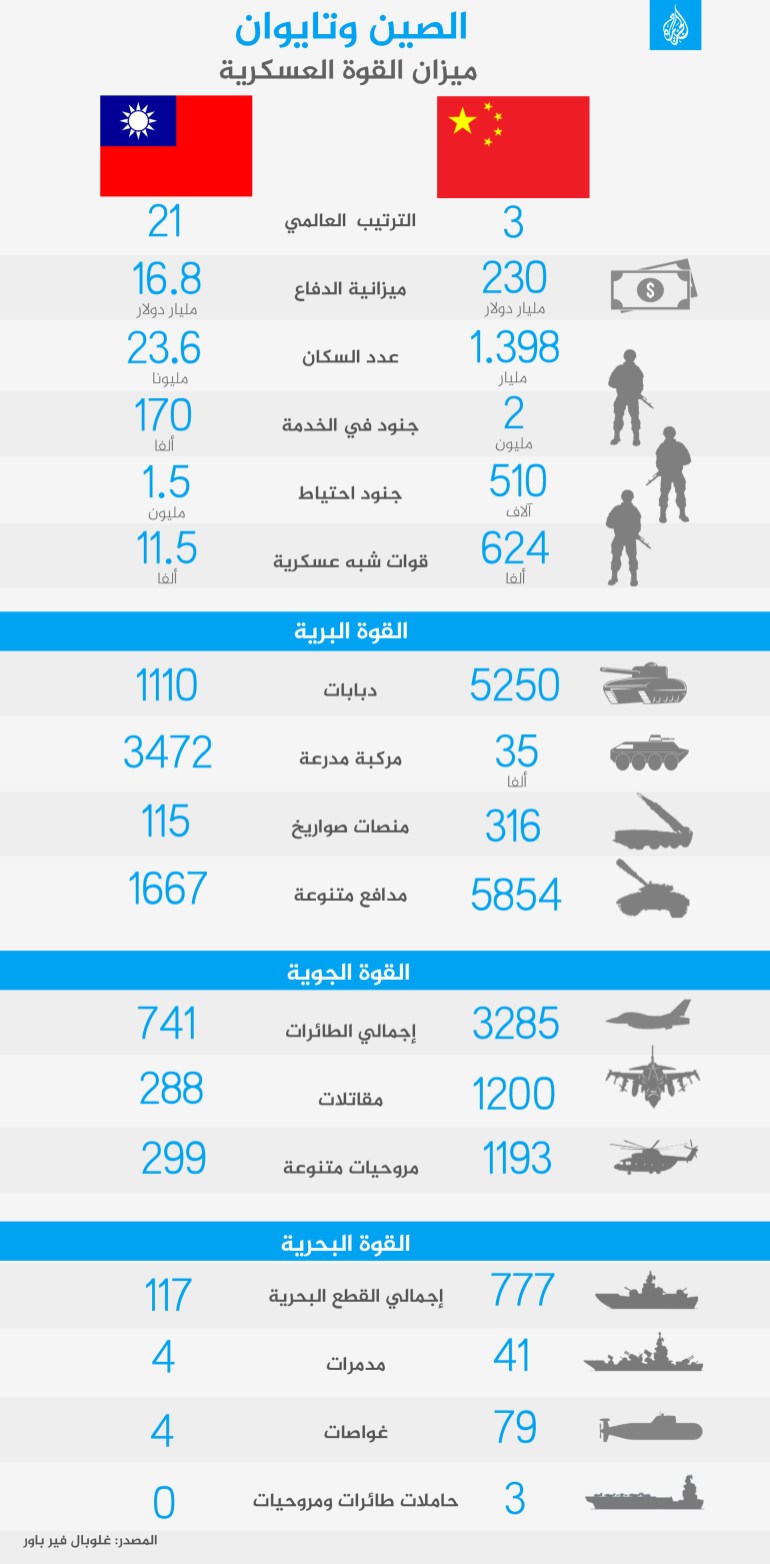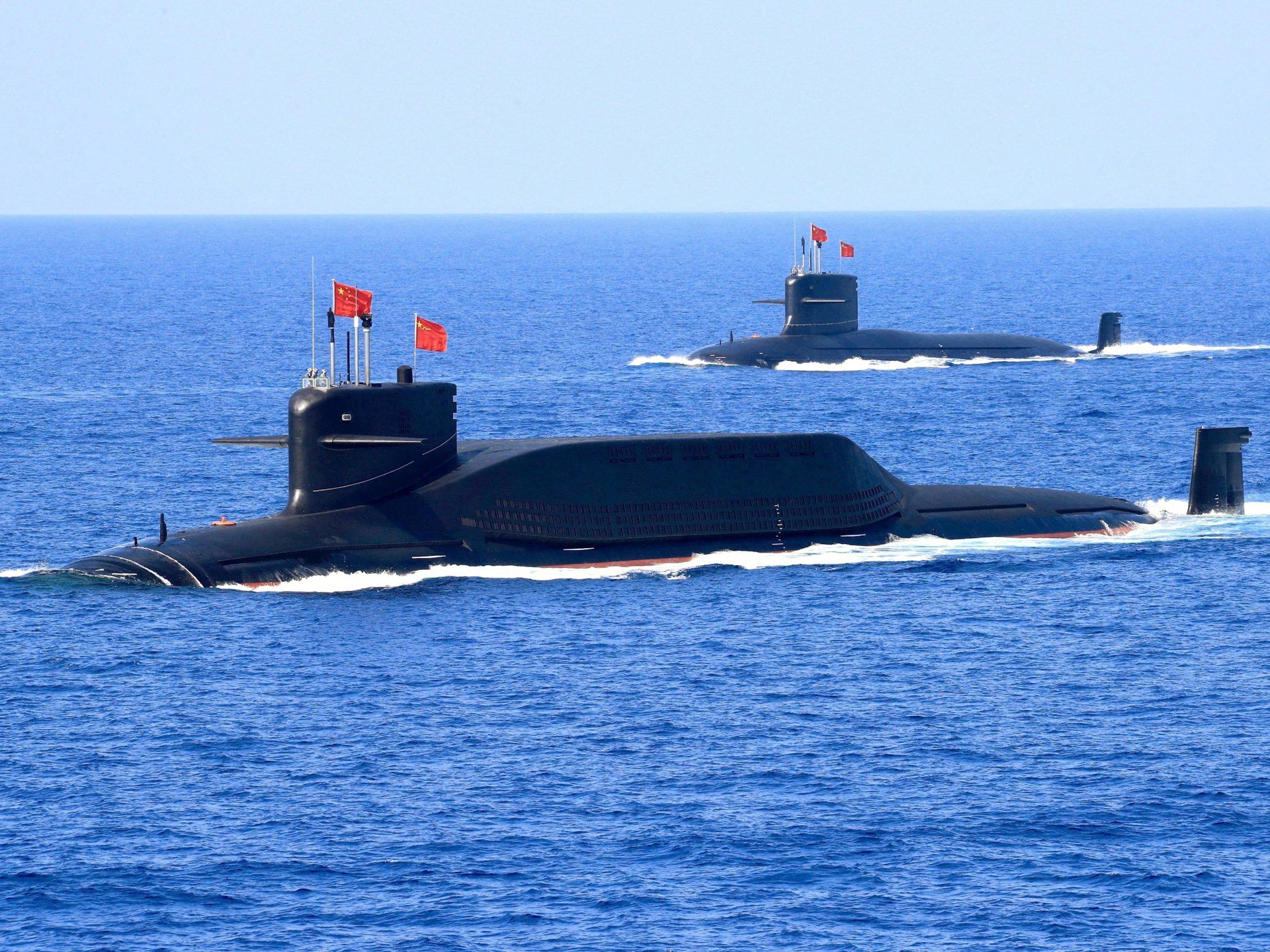In early April, China launched a series of large -scale military maneuvers, with the participation of almost all branches of its army, from the navy, air forces and missile units.
This was not just routine exercises, but rather an elaborate simulation of a scenario similar to the actual invasion of Taiwan Island, as it was evident that Beijing was testing a coordinated plan prepared in order to seize the maritime and air fields of the island, and is interspersed with siege operations of the marine corridors, and attacks on land and freedom sites hostile in the region.

In operational aspect, the training witnessed the participation of 76 combat aircraft and 21 warships, including a combat group for a aircraft carrier consisting of 8 ships, in addition to ships from the Coast Guard; It was unprecedented in the Taiwanese coast, according to what the Taiwanese Ministry of Defense announced.
However, it is noteworthy that these maneuvers came with a suspicious silence by the Chinese government, and without declaring the expected time period to end the exercises, or identify the areas of the naval, as is the custom. This ambiguity, in addition to the remarkable complexity of the maneuvers, prompted some observers to describe it as closer to the “pre -invasion process”.
China was not only satisfied with military moves, but also launched its media, according to the Washington Post, a fierce personal campaign against the Taiwanese President, Lay Cheng T, likened it to historical criminals such as Adolf Hitler, and to the bad guys of video game! He also accused him of practicing repression and liquidating his opponents with “Makareth” methods. The propaganda campaign was accompanied against the President for any military posters claiming that the Chinese army “narrows the screws” on what it described as “the separatists of Taiwan”.
How can the Chinese maneuver be read? Is there a possible escalation on the horizon revealed by the maneuver, or is it added to a series of maneuvers that China has become accustomed to during the past few years in the vicinity of Taiwan, despite the operational complexity witnessed by the current moves?
Unusual signals
There are political and military references launched by these loud maneuvers. China appears to be taking the moment, invested in the increasing concern of Taiwan from the American frequency, especially after the Trump administration’s volatile positions towards Ukraine’s support.
Beijing is trying to confirm the message, which undoubtedly worries decision makers in Taiwan, that Washington will not fight for them, and that its support for the island may be circumstantial, and Washington may exchange it with other gains that negotiate with China.
However, what is happening may be deeper than just political messages, it is likely that it is part of an integrated strategy aimed at surrounding the island in a sustainable way, in preparation for direct military action.
In this context, it can be observed that there is a qualitative shift in the philosophy of Chinese training, while the training in previous years started from scratch, that is, it starts from a simple stage gradually escalating. The year 2025 came with a remarkable change, as the army began its training from advanced and more sophisticated levels, which reflects a maturity in preparation and a different willingness.
In general, Chinese military activities around Taiwan increased in the first months of this year, where a study published by the US Naval War College indicates that the Chinese army has become more active near Taiwan than in the past years, with increasing daily operations, increasing the pace of patrols and training.
According to the study, the number of Chinese ships operating in the vicinity of Taiwan increased during January and February until it reached 419 ships, compared to 305 ships in the same period in 2024, and only 218 in 2023.

Training but with the taste of war!
In general, it is no longer possible to read the Chinese military escalation around Taiwan as just a show of muscles or transient pressure messages, but rather over time turning into something similar to the serious “rehearsals” of a possible battle. The maneuvers carried out by Beijing are closer to “realistic combat training”, practiced under conditions that simulate the actual fighting arenas, amid tangible threats, and a serious adjacent with strategic opponents, according to Beijing’s description.
The concept of “realistic combat training” does not mean merely an automatic movement of the forces, but rather includes exercise using live ammunition, in unstable environments and a difficult climatic atmosphere, and within scenarios approaching the reality of wars.
What is happening in the vicinity of Taiwan, then, is not a military parade according to what a number of military experts see, but rather an open laboratory for experience and error, and to absorb live combat lessons.
China deals with the vicinity of Taiwan as a “training field against the enemy”, where the American, Taiwanese and Japanese military presence is an irreplaceable opportunity to simulate the actual confrontation, according to the researcher “K
In confirmation of the readiness of the readiness, the exercises conducted by China in February 2025, which witnessed a wide participation of the “071” amphibious landing ships, and a “075” helicopter basin, as well as destroyers, vehicles and support ships, in the “Jia Le Tang” area southwest of the island, a site believed to be the first landing gate in the event of the outbreak of the war.
Over recent months, Beijing has escalated the pace of joint patrols between its naval and air forces around Taiwan, with the participation of origins from various branches of the army, in a pattern that confirms that it is not just exploratory sorties, but rather real exercises in which the readiness is tested and the efficiency of coordination between the various army units is measured.
All of these indicators draw a picture of a country that does not hide its willingness to use force for “unification of Taiwan”, but rather it seems to master the exploitation of these maneuvers to test the regional and international reactions, and it sends a message that China is no only training, but is prepared.
Did the zero hour approach?
The aforementioned movements cannot be read in isolation from the most comprehensive image, which is slowly formed around Taiwan, as the horizon has become tired of signs that indicate that China may approach the moment of the military decision. One of the most prominent of these indicators is the intense weather incursions carried out by Chinese warplanes in the defensive airspace of Taiwan, which exceeded 3000 times during the year 2024 alone.
These incursions are not only pressure messages or border testing, but are part of a calculated pattern called the literature of the military conflict “the war of the gray region”, that space elaborating between peace and war, where stress and provocations are practiced without exceeding the threshold that imposes a traditional military response.
According to the definition of the leadership of American special operations, the gray region is a competitive circuit in which states and actors move without complete sliding into war, but it uses hidden war tools: exhausting the opponent, collecting information, measuring reaction, and spreading fear.
In this context, Chinese air pegs appear to be a continuous test of the Taiwanese defenses, aimed at draining resources, monitoring the response pattern, and discovering weaknesses, especially in light of the increasing doubts about the extent of the United States’ commitment to defending the island.
It is not confined to the sky. In land and sea, China is working to enhance its logistical and offensive tools in preparation for the scenarios beyond mere pressure. Among the most prominent features of these preparations is the emergence of what is known as “specialized landing sandals”, known as “Choukayo Class”, which are marine mechanisms designed specifically for the transport of tanks, artillery and heavy equipment directly to the coasts that lack the infrastructure.
What distinguishes these sandals not only their load, but their ability to form floating bridges or temporary sidewalks, installed on the sea floor with metal legs, to allow vehicles to directly descend to land, under difficult marine conditions. In a scene that resembles mobile infrastructure, thus every beach becomes a potential destination, and every unpopular gap can be stormed.
Three of these sandals were already monitored in the shipbuilding basin in Guangzho in January 2025, before satellites picked them down during tests off the southern coast of China last March, and they extend their bridges on the water, and simulate the moment of access to land.
A team of defense analysts believes that these sandals represent a corner stone in the Chinese strategy to invade Taiwan, as the Chinese army gives great flexibility in choosing landing points, away from traditionally fortified sites. It represents the practical aspect of the well -being of China, a flexible plan, and insistence that by force to widen by force to a precise simulation of the details of the confrontation.
In the overall scene, China is steadily progressing towards reformulating political geography in the Strait of Taiwan, not through words or data, but through steel, iron and sky that narrows day after day.

Talent includes
Thus, developments indicate a complete readiness for China for the invasion process awaiting the political decision, as the number of Chinese forces near Taiwan has increased in the form of the largest ever, and warships from the Taiwanese coasts approached a distance of no more than 6 km (a distance almost touched the defensive pulse of the island).
In the Taiwanese depth, investigations reveal the increasing cases of intelligence infiltrators, with Chinese agents working in highly sensitive locations, which suggests that the confrontation began to actually, although this is through its hidden face.
But China is not satisfied with military excellence alone, as it adopts an elaborate legal ground that gives the invasion project the features of “legitimacy”, in what is known in the literature of war as “legal war”, and in this context, Beijing enacted the laws and activates the texts that give legal cover for any military move towards Taiwan, whether in front of the Chinese people or on the table of international public opinion.
The principle of “one China” is the backbone of this doctrine, as it depicts any step towards Taiwan as purely internal affairs, which no external force has the right to interfere in it.
This trend enhances the anti -secession law (2005), which allows China to use “non -peaceful means” if Taiwan follows the path of separation or it is not possible to achieve peaceful monotheism. Added to this is the National Security Law (2015) and the National Defense Law (2020), which support the Taiwanese file in the comprehensive national security system, to make the military solution a legal tool that is not alternative, if necessary.

When and how?
In 2021, retired American Admiral Vel Davidson launched his famous warning: China may be ready to include Taiwan by 2027.
Since then, the Davidson window has turned into an axis in the analysis of the American strategy in the Indian and Pacific Oceans. Many analysts believe that this window can accommodate between 2024 and 2028, to form an ideal period for launching a military operation, in light of China’s escalating readiness and cracks shown on the Western front, especially between the two banks of the Atlantic Ocean.
But Beijing is always a pragmatism, not only betting on the sudden blow, there is another scenario, gradually floating to the surface, entitled “The suffocating siege”, whose goal is not to invade the island, but to start isolating it, and perhaps it is subjected without a bullet, and if this does not happen, the isolation may be a prelude to the invasion.
According to military experts who spoke to Wall Street Journal, China has developed a “hybrid force” that combines military and civil elements, capable of carrying out a comprehensive siege that begins with an air strike targeting the vital infrastructure of Taiwan, from airports and ports to power stations and military facilities.
In this context, fighters fly, and the sky is covered with drones and helicopters, after which the siege begins, as warships revolve around the island, maintaining a distance from the coast of Taiwan to avoid anti -seat missiles stationed on the beach.
At the heart of the scene, a group of offensive aircraft carriers is lying in the southeast of Taiwan, from which the G-15 fighter planes are launched, whose goal is to deter any external support, specifically the American.
On the coast line, the Chinese Coast Guard is spreading, while civilian ships – from fishing boats to shipping carriers – are spread to close marine gaps. China has what can be considered a “marine militia”, which is civilian ships working in shipping or fishing that are carried out by military tasks with a civil cover.
To remove commercial ships, Chinese submarines will grown mines in the main Taiwan ports, then marine police ships monitor the area and prevent any other ships from approaching, and large shipping ships and ships will be placed in front of the ports to prevent entry and exit.
After that, the cybersecurity operation begins, and some Chinese shipping ships withdraw their seas on the sea floor with the aim of cutting the Internet cables that reach Taiwan in the world, with a Chinese electronic war that aims to lead the Taiwanese army and financial and banking systems, which drowns the country in a comprehensive chaos.
In light of this overlapping image, from the military readiness to legal mobilization, and from gray incursions to the siege engineering, China appears to be moving at a deliberate step towards its historical goal. The war may not be rushed, but in any case she no longer feared it.
(Tagstotranslate) Policy (T) Dimensions (T) Weapons and armies (T) Asia (T) China (T) Tiwan

